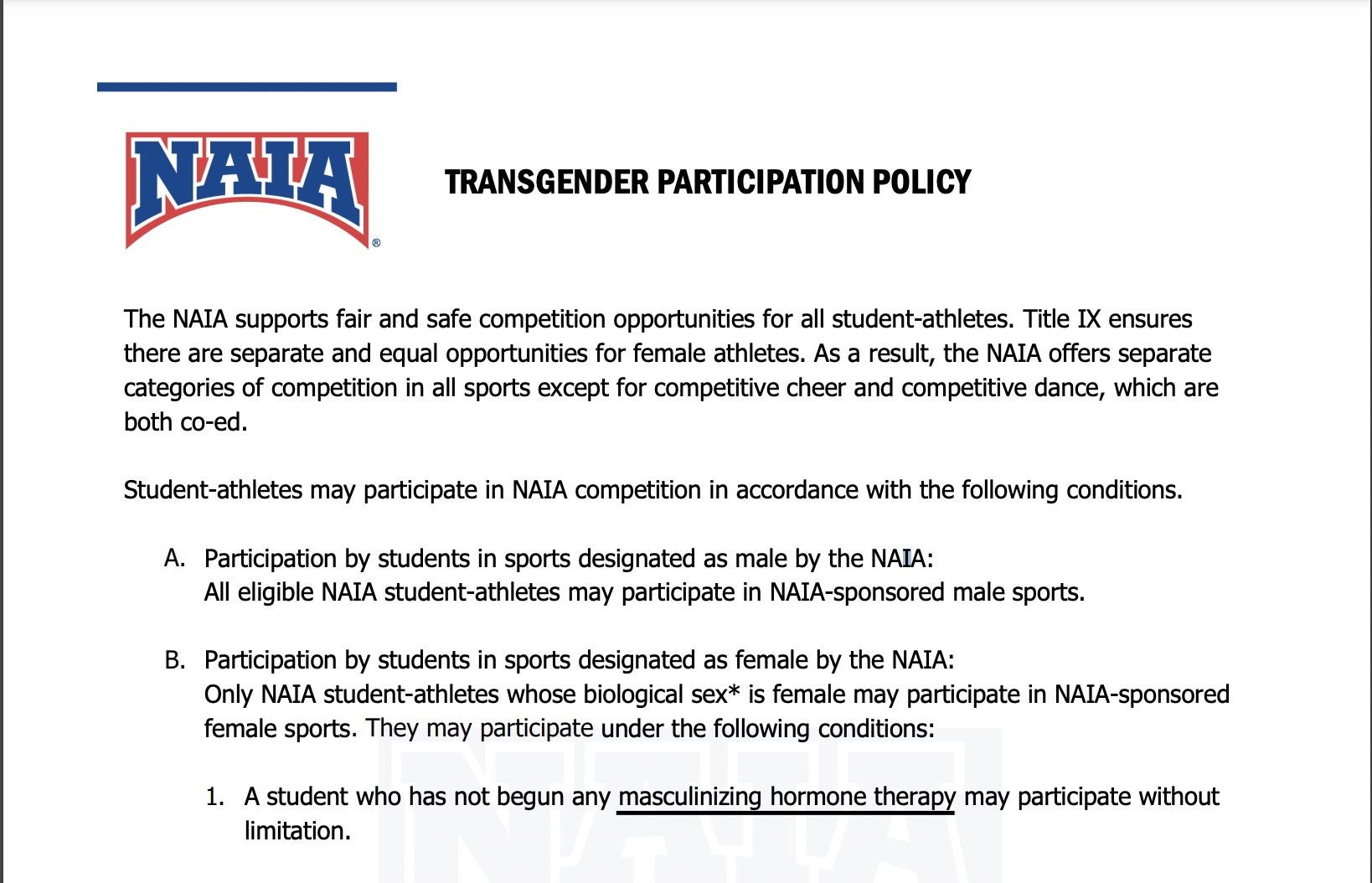NAIA Transgender Participation Policy NAIA
The National Association of Intercollegiate Athletics (NAIA) recently passed a new “Transgender Participation Policy” that essentially bans all transgender women from participating in NAIA external competitions.
NAIA’s President and CEO Jim Carr said the policy was approved out of concerns for fairness in competitions. Although there may be some concerns of fairness that may generate honest debates, this policy is a clear display of discriminatory protocols against transgender individuals.
The new policy, which was approved by a 20-0 vote, specifically states: “Participation by students in sports designated as male by the NAIA: All eligible NAIA student-athletes may participate in NAIA-sponsored male sports.”
In contrast, the section regarding female athletics reads: “Participation by students in sports designated as female by the NAIA: Only NAIA student-athletes whose biological sex is female may participate in NAIA female sports.”
The policy then goes on to list that any transgender woman who is taking any sort of hormone therapy can only participate in activities that are internal to the institution, such as workouts and practices. Transgender women cannot actually compete in their sports, which completely defeats the purpose of participating in internal team activities.
The NAIA’s decision to instill this ban has a number of flaws and many potentially dangerous repercussions.
The policy’s flaws begin at its outset with how it is worded.
In Section B, regarding the new rules for female sports, it refers to transgender female athletes as those who are taking “masculinizing hormone therapy.”
This wording is incredibly confusing as “masculinizing” refers to an individual who is taking hormone therapy to become more masculine (testosterone), but this was put under the section that refers to those who are going through the hormonal process of becoming female.
An organization who is too scared to use the term “transgender woman” in their policy writing should not have the power to be making these decisions.
Besides the sloppy writing, there are larger issues surrounding the policy to consider; and they all relate to how this will impact transgender female athletes.
For starters, it violates privacy policies. Students should not have to disclose what sort of medications they are taking to their university. Whose business is it if a student is going through a gender transition?
After the NAIA announced their new policy, Bethany College in Kansas announced that they will not be adhering to this new policy by not asking their athletes to “prove their biological sex.” The reason behind not adhering to the new policy is to respect their students’ privacy.
But the biggest issue regarding privacy of transgender athletes comes down to the policy’s possible violation of Title IX.
Title IX is a federal law that prohibits discrimination of sex and gender for students in any academic setting that receives federal funding. The enforcement of disclosing biological sex, as well as medications taken, is potentially a Title IX violation.
To further the complications of the policy, on Apr. 16, 2024, the Fourth U.S Circuit Court of Appeals found that a case of banning a transgender girl from competing in girl’s sports in West Virginia violated the girl’s rights under Title IX.
If this case in West Virginia is a violation of Title IX, then the NAIA ban should also be considered one.
Ironically, the NAIA website features a section dedicated to Title IX where they state “Title IX applies to all students regardless of gender identity.”
Their website also features some other information regarding the importance of equality, equity, and diversity in sports.
If this is the case, then why does the NAIA now have the right to prevent transgender women from competing in their sport? Additionally, why does this new policy affect only transgender women and not transgender men?
The ban only affecting transgender women is an entirely new and separate Title IX case waiting to happen.
The NAIA’s new policy can also potentially have adverse effects on any transgender female athlete as they are being ripped away from their sport that they love solely because of their gender. This is blatant gender discrimination.
Another aspect to consider is that many student athletes rely on their sports in order to pay for their tuition. Because of this, students may lose access to their right to a college education if they aren’t able to receive a scholarship. This ties right back into Title IX as the purpose of the law is to get rid of discriminative barriers preventing education.
And yet, there is still one other big question to be asked of the NAIA: what even is the point of this policy?
The number of transgender athletes in the NAIA is unknown because students do not have to report this to their university; the number of transgender athletes in the NAIA is believed to be less than 1%. Why go through so much work to potentially ruin the college experiences of a few people who just want to play their sport in peace?
Every single person should have the choice to express their gender identity however they see fit, and no one else has the right to know about what someone chooses to do with themselves.
Universities have policies such as Title IX in place to protect the most basic rights of all students. Without these basic protections, how can any college student expect to enjoy their time in higher education?
When governing bodies like the NAIA create such policies, it is important that they take into account what the real effects will be on students- what the real financial, mental, and physical effects will be.

